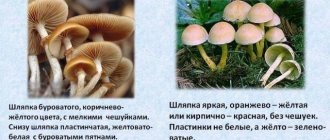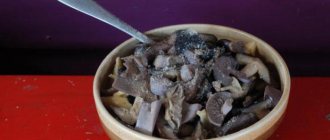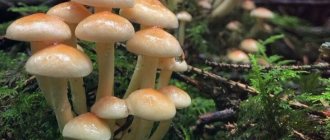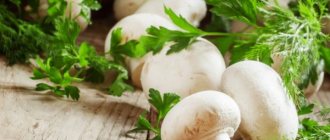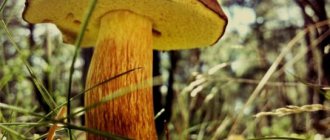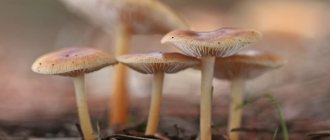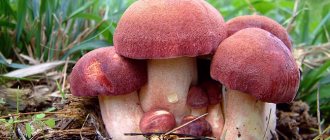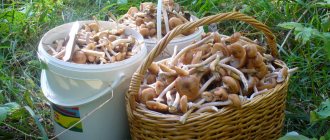Wild mushrooms everywhere attract special attention from fans of original food, because they can be boiled, fried, pickled, salted and dried. Unfortunately, in nature there are edible and false honey mushrooms, which often end up in the basket of inexperienced mushroom pickers. Before going out into the forest, it would be wise to become more familiar with the honey mushrooms that grow in the area where we live.
The main symptoms of poisoning with inedible honey mushrooms occur several hours after eating them. A sharp headache, nausea, dizziness, and intestinal spasms signal a problem.
Varieties of edible mushrooms: description, photo, when they appear, on which stumps they grow
The name of the mushrooms “honey mushrooms” translated from Latin means “bracelet”. Colonies of forest inhabitants really resemble decorations on old wood due to their peculiar form of growth.
- Mushroom pickers who go on quiet hunts in the forests of central Russia often end up with honey mushrooms in their baskets. Mushroom pickers love them because mushrooms can be used to diversify the summer menu: honey mushrooms are one of the ingredients in soups, they are salted, dried mushrooms are prepared for the winter, and fried.
- You can find a bunch of honey mushrooms in the summer on stumps, in damp places in the forest. Mushrooms grow on the bark of trees. Mushrooms like deciduous and coniferous trees. Fungus spores can also be found in dead woods - areas of the forest that are difficult for humans to reach.
- The thickets of mushrooms will provide the hunter for the forest delicacy with a hearty meal, because mushrooms grow in colonies. One expanded family of honey mushrooms can replenish the supplies of a lover of quiet hunting with 10 kg of product, and a week later a new crop of mushrooms will grow in the same place. You can collect honey mushrooms before winter.
- Since the stems have no nutritional value, only the caps are cut off when harvesting. To prevent the dish from becoming bitter, the honey mushrooms are lightly boiled beforehand.
You can find a bunch of honey mushrooms in the summer on stumps, in damp places in the forest.
How not to confuse summer honey mushrooms with poisonous mushrooms and protect your family from health problems? After all, not everyone has extensive experience hunting for honey mushrooms.
Summer honey mushrooms, which can be used to diversify the menu without fear:
- thin-walled yellowish-brown cap (at the initial stage of growth, its outer edges can curl inward)
- caps grow up to 8 cm in diameter
- underneath the cap you can see a cobwebby cover
- the cap of a young honey mushroom is not flat on top, but has a bulge in the center (the older the mushroom, the smaller the bulge)
- the surface of the cap is covered with water circles
- if you turn over the cap of an edible honey mushroom, you can see white or rusty-brown plates
- the older the mushroom, the darker and more contrasting the shade of the plates appears (the intensity of the color depends on the degree of maturation of the spore powder inside the plates, which is red-brown in its mature state)
- The length of the mushroom stem can be 8 cm, but the diameter is invariably thin - up to 0.5 cm
- the leg is brown, the ring on it is also brown
- scales are located under the ring
Summer honey fungus
Recipes for dishes and preparations
Before processing, mushrooms are thoroughly washed and cleaned. In most cases, the legs have no nutritional value (except for autumn mushrooms) and are therefore removed. To successfully wash fragile caps, they are immersed in a colander and repeatedly dipped into a basin of clean water, which is changed as they become dirty.
Pickled autumn mushrooms
For 1 kg of autumn mushrooms take 50 g of salt, 20 g of dill - herbs and seeds, 20 g of onion, allspice and bay leaf to taste.
Mushrooms are poured with boiling salted water and boiled for 20 minutes, and after cooking, drained in a colander. First, pour a thin layer of a mixture of dill with pepper and salt into the prepared container. After cooling, the workpiece is placed in a container in rows 5–6 cm thick, sprinkling each layer with a mixture of salt and spices, as well as finely chopped onions.
The pickles are covered with a piece of cloth on top, pressed down with a circle and a weight, and taken out to a cool place, making sure that the brine completely covers them, which should happen in a few days. The food is ready in two weeks, after which it is stored in the refrigerator.
Frozen honey mushrooms
One of the best ways to preserve the nutritional value of mushrooms for a long time is to freeze them. This is a simple and labor-intensive method that allows you to postpone the cooking process until the winter period, which is free from work. Before freezing, mushrooms are cleaned, washed and dried. Then the workpiece is placed in portioned plastic bags or plastic containers and placed in the freezer.
This frozen product can be stored deep frozen at -18°C until the next harvest. Having taken a portion out of the freezer, they immediately begin cooking without waiting for complete defrosting.
Canned honey mushrooms
Freshly collected caps are suitable for preservation. They are washed and filled with cold water at the rate of 200 g of water per 1 kg of mushrooms. Then cook over low heat until the juice begins to release, after which continue cooking for another half hour, skimming off the foam and stirring frequently. Salt the preparation to taste, add a little citric acid - 1 g per 1 kg of mushrooms.
Bay leaves, black pepper and allspice are placed at the bottom of the jars. The boiling caps are placed in jars and filled with mushroom broth. Preservation is sterilized for at least 40 minutes.
What is the difference between good mushrooms and their inedible counterparts?
- In order not to worry and risk your well-being, you need to know the signs of honey mushrooms that are not suitable for consumption. After all, their poisonous counterparts have excellent camouflage. For example, while hunting for mushrooms, you may encounter sulfur-yellow false honey fungus. The body of the mushroom is bright yellow and without scales.
- The plates inside the cap of the sulphuroplasty change from whitish to bluish-gray at a young age. This is not typical for edible honey mushroom. The mushroom is not included in the group of poisonous species, but it should be boiled first.
The difference between edible and poisonous mushrooms.
The honey mushroom family includes the following mushrooms:
- gray
- pine honey mushrooms
- red honey mushrooms
- dark honey mushrooms
- honey mushrooms with pimples
- meadow
- Assumption
- Chinese
- winter
- autumn
- summer
- spring honey mushrooms
- thick-legged honey mushrooms
- mucous mushrooms
- honey mushroom
Honey fungus thick-legged
Winter honey fungus
Honey fungus
Honey fungus brick-red Honey mushrooms with pimples
The common name “honey mushrooms” refers to different families and genera of mushrooms, of which there are 34 species. Of these, only 22 species have been classified. Some of the representatives of these mushrooms “settle” in open areas, in the grass, confusing inexperienced mushroom pickers.
Since edible representatives of honey mushrooms are of interest, there is more information about them.
Let's look at the most common forms:
Winter honey fungus
- A representative of this species takes root on damaged deciduous trees. Honey mushroom colonies grow on dead parts of wood, choosing willow or poplar for colonization. You can find these mushrooms on the banks of a stream, in the garden. The forest inhabitants also inhabit the city park.
- A good harvest can be harvested in the fall. Sometimes winter honey fungus adapts to germinate under the snow. The mushroom cap, 10 cm in diameter, is flat yellow or orange-brown. Young mushrooms have a flat cap, the edges are lighter in color and the middle is darker.
Autumn
honey fungus Autumn honey fungus mushroom
- Many types of trees are suitable for the germination of spores of this honey mushroom. there are about 200 of them. Sometimes the fungus even sprouts on potatoes. At night you can watch an interesting sight: due to the fact that a large “mushroom family” is often located on tree stumps, they are beautifully illuminated.
- Ideal conditions for the growth of the fungus in damp forests are birch and aspen stumps, dead elm and alder wood.
- Mushrooms can be collected from the last month of summer until the cold winter months, unless the air temperature drops below 10 degrees. The autumn honey fungus has an impressive size compared to its counterparts.
- The diameter of the cap is 17 cm, and the legs are 10 cm. The cap is greenish-olive or dark brown. Wavy edges can be observed in adult members of the fungal family. The surface of an immature mushroom is covered with scales. But there are very few of them. As the fungus grows, these scales disappear.
Summer honey fungus
Summer honey fungus
- Most often, summer honey fungus ends up in the basket. They begin to collect it from the end of March. You can bring home the harvest of these mushrooms until the last winter month.
- Summer honey mushroom grows in the forests. A dense family grows on rotten stumps. Trees with obvious damage are suitable for fungal growth.
- The dimensions of the summer honey mushroom are more modest: the cap is 6 cm in diameter, the leg is 7 cm.
- Adult mushrooms are distinguished by the presence of a wide tubercle on the surface of the cap. The caps of honey mushrooms growing in damp areas are brown and translucent. Mushrooms growing in a dry place have honey-yellow, matte caps. There are grooves along the edges of the caps. Mushrooms can produce crops all year round.
When is the best time to collect forest honey mushrooms?
Beginning mushroom pickers are interested in the question, when is the best time to collect hemp mushrooms? Knowing this, the quality of the mushroom harvest and its volume will always be 5+. Note that the season for collecting these mushrooms will depend on the type of honey mushrooms and weather conditions. For example, autumn honey mushrooms grow from mid-August to mid-November, summer honey mushrooms - from mid-April to October, and winter honey mushrooms - from late October to March.
To generalize, the peak for collecting hemp mushrooms occurs in the autumn months, especially September and October. See a photo showing autumn hemp mushrooms in the forest:
Video: Summer honey fungus (Kuehneromyces mutabilis)
Specifics of preparing honey mushrooms
- Before cooking, mushrooms should be pre-boiled. Cooking, the duration of which can vary from 30 minutes to an hour, will eliminate the inherent toxicity of honey mushrooms.
- Cooking time is determined by the size of the fruiting bodies of the mushrooms.
- The larger the mushrooms, the longer the heat treatment takes.
Before cooking, you must first boil the mushrooms.
How to properly pre-boil mushrooms:
- the mushrooms are placed on the fire and when the water boils, it needs to be drained
- then you need to cook in a new portion of previously boiled water
Interesting Facts
Scientists conducting molecular genetic research have proven that mushrooms, like animals, are the closest relatives of humans. It was discovered that their DNA has the maximum similarity to the animal.
It has also been proven that the first specimens appeared on Earth earlier than dinosaurs. The approximate time of their origin is 400 million years ago. They can be called the oldest inhabitants of the planet, who changed over time.
Information sources
- Alan Bessette, Arleen Rainis Bessette, David William Fischer. Mushrooms of Northeastern North America. — Syracuse University Press, 1997
- Gribi Khmelnytchini. Chief assistant. Govorun V. D., Tymoshchuk O. O. - Khmelnitsky: Polygraphist-1, 2014
False honey mushrooms: description, photo
You can mistake its double for a good mushroom. These are the so-called false mushrooms.
You can mistake its double for a good mushroom
Signs of inedible honey fungus:
- the cap is bright in color (a good mushroom has a cap of a muted shade and has scales on it in young mushrooms)
- the plates of the bad mushroom are yellow, greenish, olive-black
- the double of the edible honey mushroom has only the remains of a ring on the stem
Dangerous double honey mushrooms
Galerina bordered
(Galerina marginata) - deadly poisonous. Grows from June to the end of October on stumps and rotten wood, mainly coniferous trees (less often deciduous). Sometimes appears on the ground that contains fragments of decaying wood. Most often found in small groups. This mushroom has the greatest similarity with summer honey fungus, and relatively little with winter honey fungus. The main difference between the bordered galerina and the summer honey fungus is the absence of scales on its stem. In addition, summer honey mushrooms have a pronounced, pleasant mushroom smell, while in galerina it is extremely weak (according to some sources, slightly mealy). The mushroom contains amatoxins, the same ones found in the toadstool. Symptoms of poisoning appear 6-30 hours after eating mushrooms. A lethal dose is approximately 20-30 small fungi.
Video: inedible mushrooms - gray-yellow false honey fungus
- The brick-red false honey fungus is especially dangerous. It can be found on dead wood, on a rotten stump, and can also grow on flat terrain. The mushroom has a spherical cap, by which it is easy to “calculate” during mushroom harvesting. The cap has flakes hanging down the edges. The mushroom has no smell.
- All false honey mushrooms differ in the shades of the internal plates located under the cap. They can range from dark to sulfur-yellow or black-olive. Plates of good cream-colored mushrooms. False honey mushrooms grow in large groups.
False honey fungus sulfur-yellow
Main characteristics of honey mushrooms
A common occurrence is a family of honey mushrooms arranged in a ring. Because of this interesting feature, honey fungus received its scientific name, which translates as “bracelet.” It is quite difficult to come across a specimen growing in splendid isolation - this type of honey mushroom exists, but it is not very common.
The best “cradle” for these delicate mushrooms is rotten wood and rotten stumps - not only in spruce forests and deciduous thickets, but also on the edges, under bushes, in meadow spaces.
The mushrooms have an easily recognizable shape - thin legs, about 15 centimeters long, with a round cap on top with an edge slightly bent inward. The plates are clearly visible on the underside. The legs are decorated with “skirts”. The smooth cap has a very pleasant color: from light cream to reddish brown.
How to identify and distinguish edible honey mushrooms from false ones?
- A bad honey mushroom, unlike a good mushroom, does not have a ring - a plate-shaped skirt, which is located under the cap. You can see the remains of a bedspread on the leg.
- If the mushroom is in doubt, it is better to throw it away immediately. Send mushrooms to the basket only if you are sure that they are edible, and if you have doubts or find one of the signs of a poisonous mushroom, then give up the idea of adding it to your “mushroom catch”.
What other differences exist:
- a good mushroom has a pleasant mushroom aroma, while a false one exudes an unpleasant earthy odor or no odor at all
- the cap of a bad mushroom is brightly and loudly colored, the cap of a good mushroom is an unsightly light brown color
- the caps of good mushrooms have small scales, while poisonous mushrooms have a smooth cap (however, the scales disappear over time and the caps of edible mushrooms also become smooth)
- turning over the cap of an inedible mushroom, you can see that its plates are yellow if the mushroom is young, or greenish, olive-black if the mushroom is old (the plates of good mushrooms are cream-colored or yellowish-white)
- false honey mushrooms with a bitter aftertaste, but you should not start assessing the taste of the mushroom you doubt (other, more obvious signs are sufficient)
False mushroom
For an experienced mushroom picker, it will not be difficult to distinguish a good mushroom from a bad one. But if you are a beginner mushroom picker, then it is better to look for a skirt on the stem of the mushroom.
Features of your favorite autumn mushrooms
To learn to distinguish edible and false honey mushrooms from each other, it is important to have a good understanding of the growth characteristics of these plants. As you know, in nature there are many different types of honey mushrooms. But they are all united by the common characteristics of these cute mushrooms. It turns out that it is not enough to know what mushrooms look like from the outside. It is important to get to know them better.
Edible mushrooms most often grow in large groups near stumps or with tree roots protruding from the soil. When they just emerge from the soft forest soil, they are decorated with a semicircular cap. In older specimens, it completely changes shape. Now it looks more like a wide plate turned upside down.
Looking at the photos of false and edible honey mushrooms, you can notice differences in the coloring and size of the caps. These can be the following shades:
- orange;
- rusty yellow;
- brownish;
- honey yellow.
The diameter of the cap reaches up to 10 cm. Its outer part is covered with scales, which partially disappear over time. The dorsal plates of the cap of young honey mushrooms are usually light-colored. In mature specimens they are colored brown or yellowish.
If you carefully examine the legs of edible specimens, you will notice that they are hollow inside. In addition, they are decorated with a leathery ring, which was formed from the protective covering of a young mushroom.
The pulp has a light brown color, which does not change even when water gets on it.
How can you tell the difference between edible mushrooms and toadstools?
- The white and greenish tint of the body of the mushroom is the main sign of toadstool. The appearance of a forest dweller may well correspond to the description of an edible mushroom. An experienced mushroom picker will immediately recognize such a disguise.
- Throw an onion into the container in which the mushrooms are cooked. If it quickly turns blue, then all forest prey is not suitable for food.
- A mushroom with an olive or pearlescent tint may be poisonous. It’s better not to take risks and immediately abandon the intention of replenishing your catch in the basket.
Toadstool
Death cap
Where do honey mushrooms grow in autumn?
It is very important to learn to distinguish real varieties of autumn mushrooms from false ones by appearance, since they grow in the same places.
Reference! In itself, any honey fungus is a harmful parasite that settles on trees and often becomes the cause of dangerous diseases.
Autumn-type honey mushrooms are found on almost all trees, but they especially often form mycorrhiza with birch. Fruiting bodies can form on both living and dead trunks.
Mushroom picking is best done in old birch forests with a large number of stumps and old fallen trees. They are often found in clearings and swampy alder forests.
On coniferous trees, these forest gifts are less common.
Can there be honey mushroom poisoning, and what are the symptoms?
- Poisonings occur mainly due to ignorance of the species of forest guests or due to improper preparation of edible mushrooms. The degree of intoxication depends on what mushrooms were eaten.
- Those who independently collect mushrooms and prepare them need to know how to identify poisoning and what medical care should be provided to the victim.
Mushroom poisoning
Mushrooms are divided into several groups:
- Edible: such mushrooms can be eaten without prior boiling (champignons); partially safe mushrooms require special processing before cooking to remove toxic substances: soaking, boiling, drying, additional boiling (if this step is ignored, poisoning cannot be avoided) (false honey mushrooms)
- Inedible mushrooms may be poisonous or have an unpleasant taste or odor (gall mushroom)
False mushrooms contain a white liquid in their pulp. It's called burning juice. In addition, the bad mushroom differs from the edible honey fungus by having a brighter orange cap and a thinner stump.
Useful properties of honey mushrooms
The product is low-calorie, contains many minerals and vitamins, including thiamine. Lots of potassium, phosphorus, iron, zinc, as well as amino acids and fiber. Vitamins mainly of groups B, C, E, PP.
Honey mushrooms contain the most proteins (2.2/100 g), and carbohydrates are only 0.5/100 g. Fat content is 1.2/100 g.
Due to the high content of microelements (100 g is the daily requirement, ensuring a good level of hemoglobin), you can effectively support the functioning of the cardiovascular system if you regularly add honey mushrooms to your diet. There is no harm from them, provided they are pre-treated before cooking.
It is important to remember that you should not eat mushroom dishes at night, as they will be difficult to digest. In addition, excessive use of honey mushrooms can cause diarrhea. You should start consuming these mushrooms at the age of 12, when the digestive system is ready to process this product.
Video: How to recognize mushroom poisoning?
Signs of poisoning:
- intoxication appears within 1 hour or within 6 hours
- the malaise resembles food poisoning: a person begins to feel unwell, he develops nausea, vomiting and diarrhea may begin
- possible unpleasant or painful sensations in the abdomen
- if the poisoning is mild, then after a few days recovery occurs
Death does not occur from poisoning with false honey mushrooms, but serious problems due to dehydration and gastroenteritis are possible.
Intoxication appears within 1 hour or within 6 hours
- If signs of poisoning are detected, you should not hesitate to call an ambulance. After all, it is necessary to avoid the penetration of harmful toxic substances into the blood.
- After the milky juice of the mushrooms enters the liver, the patient’s condition worsens.
Mushroom season
These are all-season mushrooms. As soon as one species becomes uncomfortable, it is replaced by another species that is more resistant to cold or, on the contrary, better adapted to heat. Therefore, air temperature does not matter.
However, the most fertile time is considered to be late autumn and early spring - because at this time it rains the most, and high humidity, due to which there are many damp surfaces, is a priority condition for a bountiful harvest of honey mushrooms.
Video: Mushroom poisoning! Symptoms and first aid!
First aid is as follows:
- it is necessary to avoid dehydration and help get rid of the symptoms of poisoning; induce vomiting after drinking large amounts of warm boiled water and pressing on the root of the tongue
- It is also necessary to rinse the stomach for those who have eaten the same mushrooms, but there are no signs of poisoning until the symptoms become noticeable
- Dehydration can be detected by a change in the color of the urine, which becomes darker, and by fewer or no trips to the toilet.
- the patient should be provided with plenty of fluids, preferably water
- if diarrhea or vomiting has already begun, then sports drinks (not energy drinks) will help.
- the patient can eat vegetable and chicken broths, which will provide the necessary replenishment of water and nutrients
- Do not drink anti-diarrhea medications (diarrhea removes toxins from the body)
- it is better for the patient to reduce physical activity and sleep more so that the body recovers faster
Remember that first aid cannot replace treatment. If you have dehydration that you cannot cope with on your own, you should consult a doctor.
Growing at home
These mushrooms are perfect for growing at home. One of the most popular methods is cultivation on stumps. On the stump of an apple, pear or birch tree you need to plant small pieces of honey mushrooms and cover them with moss. You will be able to collect your first mushrooms within a year.
Irina Selyutina (Biologist):
When choosing a base for growing (stumps), it is important to ensure that it is not affected by the mycelium of parasitic fungi (tinder fungi). To create the necessary moisture, the stumps are soaked for 2-3 days with complete immersion in water or with periodic (during the day) watering. The following methods are used to populate stumps:
- Purchased mycelium.
- Part of the mycelium is from the forest.
- Seed material from caps.
To prevent the developing mycelium from “moving” onto healthy trees on your site, a ditch at least 30 cm deep and 10-15 cm wide is dug around the stumps at a distance of 2 m.
Stumps infected with mycelium are covered (dropped in) for the winter and covered from above to protect the ends from melt water.
For city dwellers there is another way - growing in glass jars. Plant small pieces of mushrooms in a special mixture consisting of boiled bran, sawdust, starch, and flour. This method is amazing in its speed. In a month, expect the first harvest.
How to grow honey mushrooms in the country?
- Contrary to popular belief that honey mushrooms germinate better in the forest, growing them in the country is not a fantastic idea.
- From fertile soil brought to the site, humus obtained somewhere in the forest, mushroom spores fall into the ground. However, annual digging of the site disturbs the mycelium and it eventually dies without having time to germinate.
How to grow honey mushrooms at the dacha
How to harvest mushrooms at the dacha?
- select an area for mushrooms (moist, with shade)
- prepare mushroom mycelium (in our case, honey mushrooms) and “settle” the mushrooms on the future mushroom plantation.
First stage: site preparation:
- For honey mushrooms to germinate, a stump is needed, so we stock up on old, rotten birch wood (suitable trees: beech, hornbeam, alder, aspen, oak)
- choose wood (stump length - 20-30 cm) with chips and crevices to facilitate the process of rooting spores on the stump
- if there are no chips, then we make longitudinal notches using an ax
- immerse the selected hemp in water for 1-2 hours
- we dig in the stumps on the future mushroom plantation (entirely or only part of the stump, bury the wood vertically or lying on its side)
Preparing the site and wood
Preparing the mycelium:
- We find overgrown mushrooms in the forest, which have large and wet caps
- immerse mushrooms in soft ground water
- leave for a couple of hours
- mix the mixture well
- stumps and logs buried in the area are treated with a liquid containing fungal mycelium
- We don’t throw away the caps, but place them on top of the treated areas of wood
- cover the caps with a piece of hemp (you can use moss from the forest or rotted sawdust for this)
- when it’s hot outside, we moisten the area so that it always remains damp
- We are waiting for the first harvest. Usually, mushrooms can be collected from a prepared plot only 2-3 years after planting.
How to grow honey mushrooms in the country
Where to pick mushrooms
In search of honey mushrooms, it is worth examining ravines, stumps, swampy areas, old thickets where it is damp and impassable. The main distribution area is the northern hemisphere of our planet; here they are found almost everywhere, and do not grow only in permafrost. Russians and the population of Eastern Europe have known honey mushrooms for a very long time.
- The main condition for the growth of these mushrooms is the presence of stable humidity.
- For example, it is useless to look for them in a coniferous forest, near which there are no mountains - it is too dry there for honey mushrooms.
- But the deciduous forest is rich in these beauties: one good rotten stump, and you can provide yourself with lunch with mushrooms and dinner.
- Moreover, here honey mushrooms will probably grow all year round, regardless of the presence of a body of water nearby.
The type of tree also matters: there is a high probability of encountering a family of honey mushrooms on birch or linden wood, but stumps from dead oaks, acacias, maples and other trees should not be ignored either.
These mushrooms feel most comfortable in the shade; they avoid direct sunlight.
A variety of meadow mushrooms
Honey mushrooms, called meadow mushrooms, are considered edible non-poisonous mushrooms. This is a non-rotting mushroom. Very similar to the real one.
